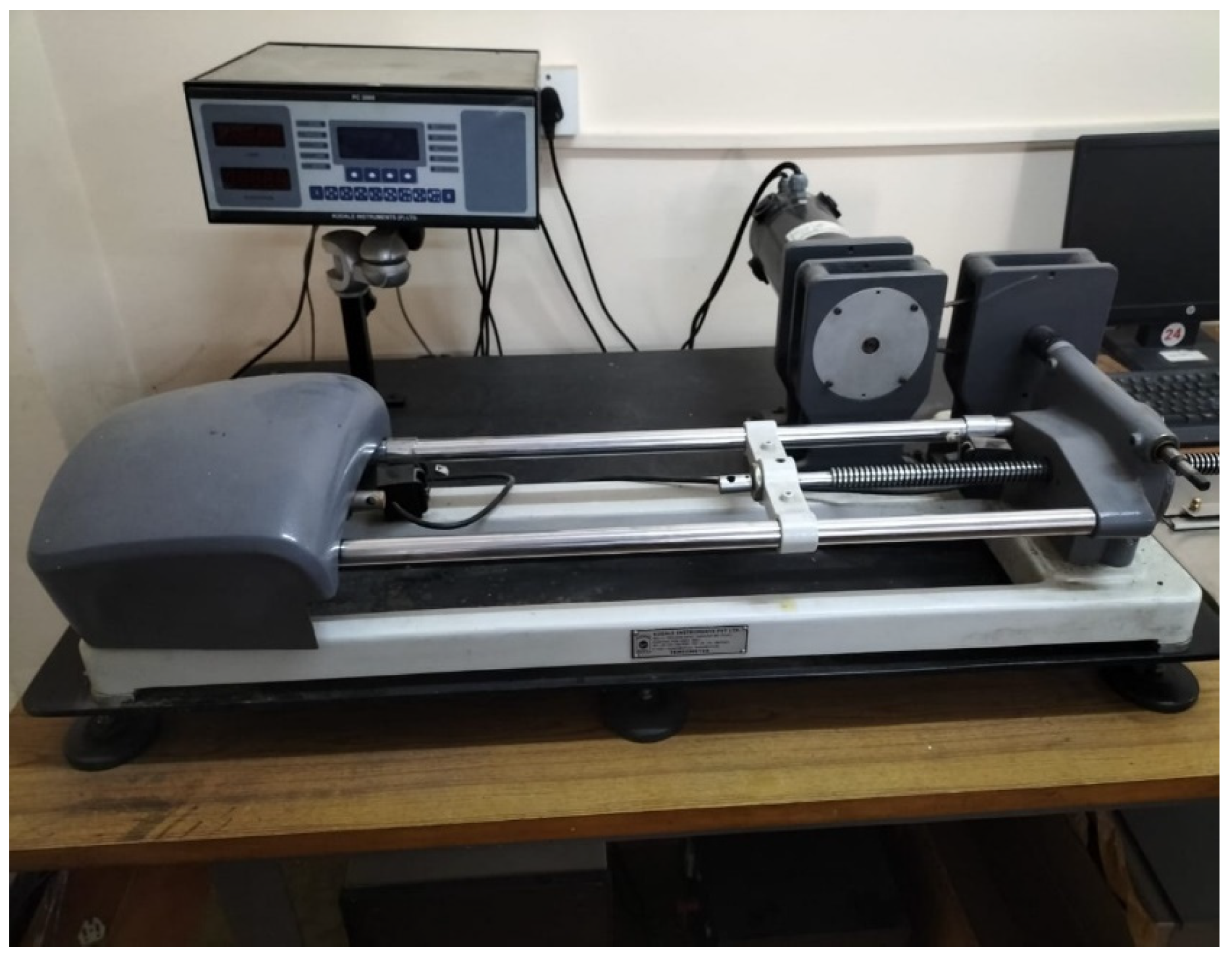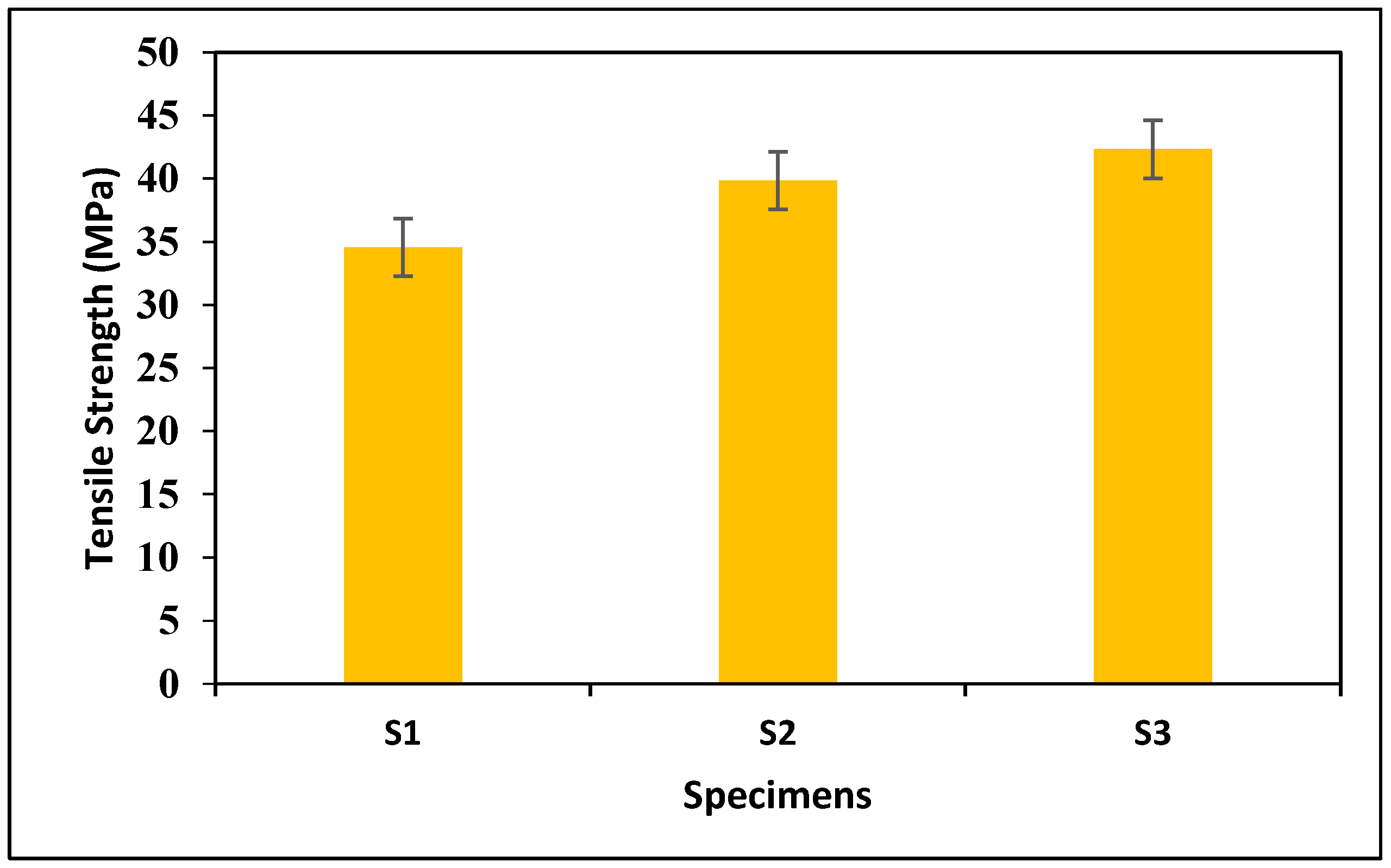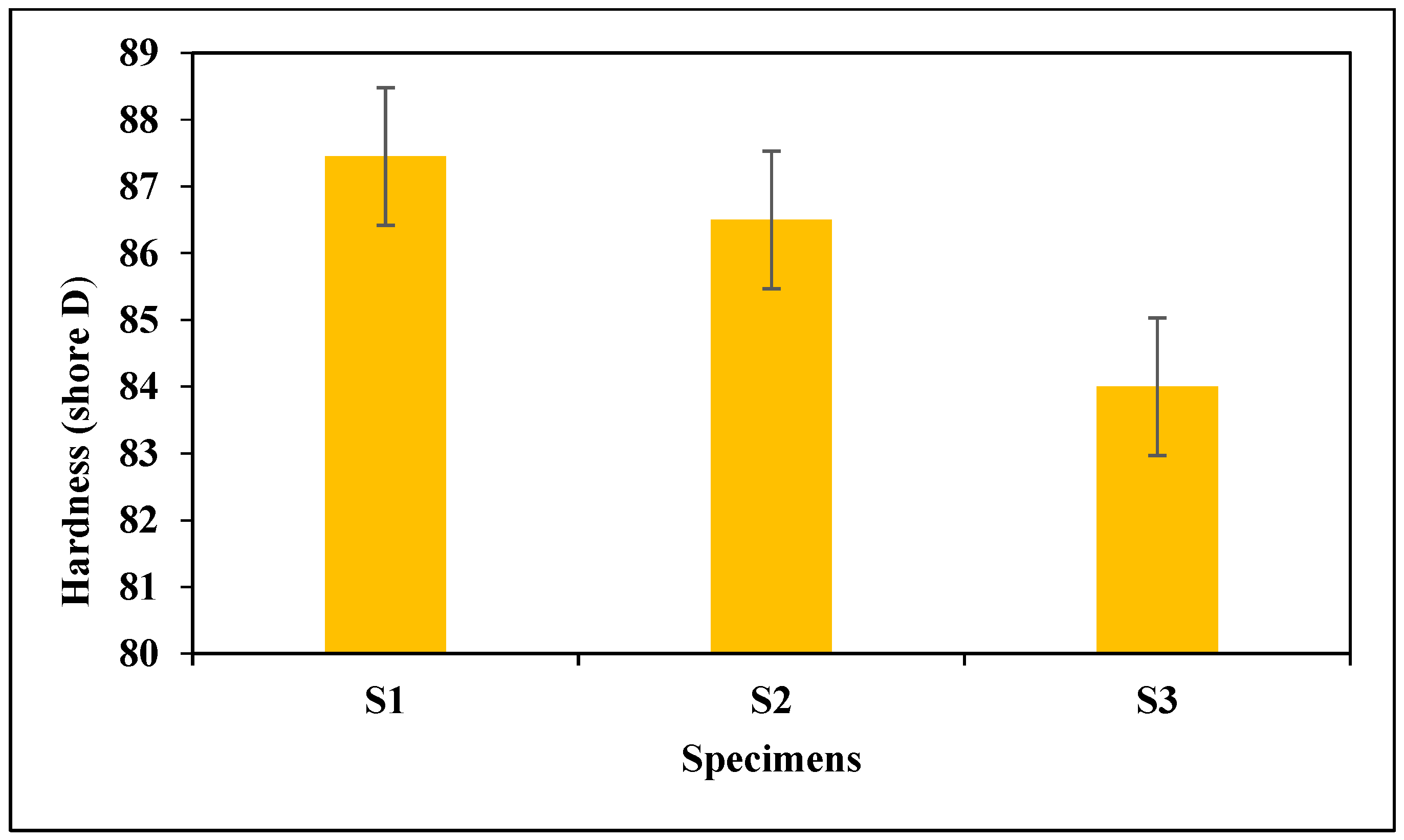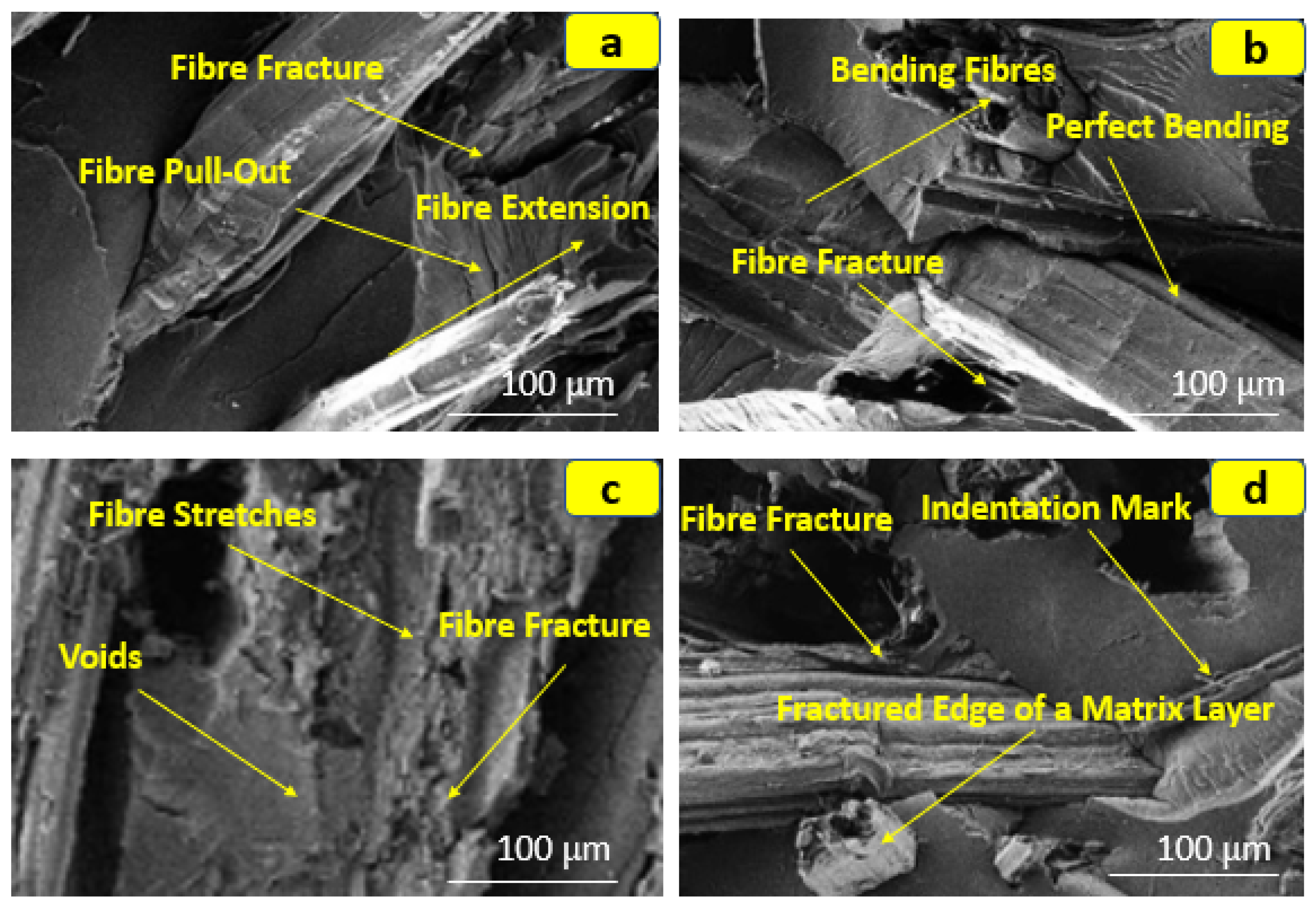Kenaf Fiber and Hemp Fiber Multi-Walled Carbon Nanotube Filler-Reinforced Epoxy-Based Hybrid Composites for Biomedical Applications: Morphological and Mechanical Characterization
Abstract
1. Introduction
2. Materials and Methods
3. Experimental Procedure
4. Results and Discussion
4.1. Tensile Test
4.2. Flexural Test
4.3. Impact Strength
4.4. Hardness Test
4.5. Mechanical Characteristics of the Composites
4.6. Morphological Characterization
5. Implications, Conclusions, Limitations, and Future Scope
5.1. Implications
5.2. Conclusions
5.3. Limitations
5.4. Future Scope
Author Contributions
Funding
Institutional Review Board Statement
Informed Consent Statement
Data Availability Statement
Acknowledgments
Conflicts of Interest
References
- Ismail, A.S.; Jawaid, M.; Sultan, M.T.H.; Hassan, A. Physical and mechanical properties of woven kenaf/bamboo fiber mat reinforced epoxy hybrid composites. Bioresources 2019, 14, 1390–1404. [Google Scholar] [CrossRef]
- Gopinath, A.; Kumar, M.S.; Elayaperumal, A. Experimental Investigations on Mechanical Properties of Jute Fiber Reinforced Composites with Polyester and Epoxy Resin Matrices. Procedia Eng. 2014, 97, 2052–2063. [Google Scholar] [CrossRef]
- Chin, S.C.; Tee, K.F.; Tong, F.S.; Ong, H.R.; Gimbun, J. Thermal and mechanical properties of bamboo fiber reinforced composites. Mater. Today Commun. 2020, 23, 100876. [Google Scholar] [CrossRef]
- Korisidda, M.; Prasad, C.; Mahantesh, B.C.; Sheregar, S.S.; Praveena, B. Study on mechanical properties of bio-composites. Int. J. Sci. Res. Dev. 2018, 6, 1–5. [Google Scholar]
- Praveena, B.A.; Kumar, S.V.; Manjunath, H.N.; Sachin, B.; Yadav, S.P.S.; Lochan, B.R.; Kumar, G.L.A.; Reddy, J.S. Investigation of moisture absorption and mechanical properties of natural fibre reinforced polymer hybrid composite. Mater. Today Proc. 2021, 45, 8219–8223. [Google Scholar] [CrossRef]
- Maino, A.; Janszen, G.; Di Landro, L. Glass/Epoxy and Hemp/Bio based epoxy composites: Manufacturing and structural performances. Polym. Compos. 2019, 40, E723–E731. [Google Scholar] [CrossRef]
- Netinger Grubeša, I.; Marković, B.; Gojević, A.; Brdarić, J. Effect of Hemp Fibres on Fire Resistance of Concrete. Constr. Build. Mater. 2018, 184, 473–484. [Google Scholar] [CrossRef]
- Panthapulakkal, S.; Sain, M. Studies on the Water Absorption Properties of Short Hemp—Glass Fiber Hybrid Polypropylene Composites. J. Compos. Mater. 2007, 41, 1871–1883. [Google Scholar] [CrossRef]
- Praveena, B.A.; Shetty, B.P.; Vinayaka, N.; Srikanth, H.V.; Yadav SP, S.; Avinash, L. Mechanical properties and water ab-sorption behaviour of pineapple leaf fiber reinforced polymer composites. Adv. Mater. Process. Technol. 2020, 6, 1–16. [Google Scholar]
- Praveena, B.A.; Shetty, B.P.; Sachin, B.; Yadav, S.P.S.; Avinash, L. Physical and mechanical properties, morphological be-haviour of pineapple leaf fiber reinforced polyester resin composites. Adv. Mater. Process. Technol. 2020, 6, 1–14. [Google Scholar]
- Praveena, B.A.; Shetty, B.P.; Akshay, A.S.; Kalyan, B. Experimental study on mechanical properties of pineapple and banana leaf fiber reinforced hybrid composites. AIP Conf. Proc. 2020, 2274, 030015. [Google Scholar]
- Santosh Kumar, D.S.; Praveen, B.A.; KiranAithal, S.; Kempaiah, U.N. Development of pineapple leaf fiber reinforced epoxy resin composites. Int. Res. J. Eng. Technol. 2015, 2, 3. [Google Scholar]
- Patil, S.S.; Praveen, B.A.; Kempaiah, U.N.; Adarsha, H. Fabrication and characterization of Kevlar/jute reinforced epoxy. Int. Res. J. Eng. Technol. 2017, 4, 9. [Google Scholar]
- Anilthota, H.G.; Praveena, B.A. Processing and characterization of green composites using sisal and palm fibres. Int. J. Eng. Sci. Comput. IJESC 2017, 7, 4262–4265. [Google Scholar]
- Salentijn, E.M.J.; Zhang, Q.; Amaducci, S.; Yang, M.; Trindade, L.M. New developments in fiber hemp (Cannabis sativa L.) breeding. Ind. Crops Prod. 2015, 68, 32–41. [Google Scholar] [CrossRef]
- Praveena, B.A.; Shetty, B.P.; Kalasi, M.S.S.; Yadav, S.S.; Prasad, M.; Sujith, M.N.; Reddy, N.; Mallikarjun, L. Design and development of smart manhole. IOP Conf. Ser. Mater. Sci. Eng. 2021, 1013, 012006. [Google Scholar] [CrossRef]
- Pappu, A.; Pickering, K.L.; Thakur, V.K. Manufacturing and characterization of sustainable hybrid composites using sisal and hemp fibres as reinforcement of poly (lactic acid) via injection moulding. Ind. Crops Prod. 2019, 137, 260–269. [Google Scholar] [CrossRef]
- Moulya, H.V.; Vasu, V.K.; Praveena, B.A.; Rajesh, M.; Ruthuparna, S.A.; Rahul, K. Study on acoustic properties of polyester—Fly ash cenosphere\nanographene composites. Mater. Today Proc. 2022, 52, 1272–1277. [Google Scholar]
- Sature, P.; Mache, A. Mechanical characterization and water absorption studies on jute/hemp reinforced hybrid composites. Am. J. Mater. Sci. 2015, 5, 133–139. [Google Scholar]
- Anand, P.B.; Lakshmikanthan, A.; Chandrashekarappa, M.P.G.; Selvan, C.P.; Pimenov, D.Y.; Giasin, K. Experimental Investigation of Effect of Fiber Length on Mechanical, Wear, and Morphological Behavior of Silane-Treated Pineapple Leaf Fiber Reinforced Polymer Composites. Fibers 2022, 10, 56. [Google Scholar] [CrossRef]
- Praveena, B.A.; Shetty, B.P.; Lokesh, N.; Santhosh, N.; Buradi, A.; Mahesh; Sunil; Jalapur, R.; Sharanu. Design of injection mold for manufacturing of cup. In Recent Advances in Mechanical Engineering, Lecture Notes in Mechanical Engineering; Pradhan, P., Pattanayak, B., Das, H.C., Mahanta, P., Eds.; Springer: Singapore, 2023. [Google Scholar]
- Pil, L.; Bensadoun, F.; Pariset, J.; Verpoest, I. Why Are Designers Fascinated by Flax and Hemp Fibre Composites? Compos. Part A Appl. Sci. Manuf. 2016, 83, 193–205. [Google Scholar] [CrossRef]
- Praveen, B.; Abhishek, S.U.; Shetty, P.B.; Reddy, J.S.; Praveena, B.A. Industry 4.0 researchers computer numerical control machine tool to manufacture calligraphy board, emerging research in computing, information, communication and applications. In Lecture Notes in Electrical Engineering; Springer: Singapore, 2022; Volume 790. [Google Scholar]
- Nagaraja, S.; Bindiganavile Anand, P.; Mahadeva Naik, R.N.; Gunashekaran, S. Effect of aging on the biopolymer composites: Mechanisms, modes and characterization. Polym. Compos. 2022, 43, 4115–4125. [Google Scholar] [CrossRef]
- Väisänen, T.; Batello, P.; Lappalainen, R.; Tomppo, L. Modification of Hemp Fibres (Cannabis sativa L.) for Composite Appli-cations. Ind. Crops Prod. 2018, 111, 422–429. [Google Scholar] [CrossRef]
- Yadav, S.P.S.; Shankar, V.K.; Avinash, L.; Buradi, A.; Praveena, B.A.; Vasu, V.K.; Vinayaka, N.; Kumar, K.D. Development of 3D Printed Electromyography Controlled Bionic Arm, sustainable machining strategies for better performance. In Lecture Notes in Mechanical Engineering; Springer: Singapore, 2022. [Google Scholar]
- Hepworth, D.; Hobson, R.; Bruce, D.; Farrent, J. The use of unretted hemp fibre in composite manufacture. Compos. Part A Appl. Sci. Manuf. 2000, 31, 1279–1283. [Google Scholar] [CrossRef]
- Vinayaka, N.; Akshaya, C.; Praveena, B.A.; Praveen Kumar, U.B.; Marulasiddeshi, H.B. Study of supercritical airfoil aero-dynamics at various turbulence intensities and Mach numbers in transonic regime. High Technol. Lett. 2021, 27, 1006–6748. [Google Scholar]
- Praveena, B.A.; Ahmed, M.M.; Kedambadi, V.; Kempaiah, U.N. The design, optimization and analysis of office Chair Base, based on the European standards. Int. J. Mech. Prod. Eng. Res. Dev. 2018, 8, 85–92. [Google Scholar]
- Praveena, B.A.; Santhosh, N.; Archana, D.P.; Buradi, A.; Raj, E.F.I.; Chanakyan, C.; Elfasakhany, A.; Basheer, D. Influence of Nanoclay Filler Material on the Tensile, Flexural, Impact, and Morphological Characteristics of Jute/E-Glass Fiber-Reinforced Polyester-Based Hybrid Composites: Experimental, Modeling, and Optimization Study. J. Nanomater. 2022, 2022, 17. [Google Scholar] [CrossRef]
- Santhosh, N.; Praveena, B.A.; Srikanth, H.V.; Angadi, S.; Gunge, A.; Rudra Naik, M.; Shankar, G.; Ramesha, K.; Ravichandran, G. Experimental investigations on static, dynamic, and morphological characteristics of bamboo fiber-reinforced polyester composites. Int. J. Polym. Sci. 2022, 2022, 1916877. [Google Scholar] [CrossRef]
- Praveena, B.A.; Abdulrajak, B.; Santhosh, N.; Kedambadi, V.K.; Jaibheem, H.; Huliya, D. Study on characterization of mechanical, thermal properties, machinability and biodegerability of natural fiber reinforced polymer composites and its applications, recent developments and future potentials: A comprehensive review. Mater. Today Proc. 2021, 52, 1255–1259. [Google Scholar]
- Yogeshwaran, S.; Natrayan, L.; Udhayakumar, G.; Godwin, G.; Yuvaraj, L. Effect of waste tyre particles reinforcement on mechanical properties of jute and abaca fiber-epoxy hybrid composites with pre-treatment. Mater. Today Proc. 2020, 37, 1377–1380. [Google Scholar] [CrossRef]
- Praveena, B.A.; Santhosh, N.; Buradi, A.; Srikanth, H.V.; Shankar, G.; Ramesha, K.; Manjunath, N.; Karthik, S.N.; Naik, M.R.; Kumar, S.P. Experimental Investigation on Density and Volume Fraction of Void, and Mechanical Characteristics of Areca Nut Leaf Sheath Fiber-Reinforced Polymer Composites. Int. J. Polym. Sci. 2022, 2022, 6445022. [Google Scholar] [CrossRef]
- Lakshumu Naidu, A.; Jagadeesh, V.; Raju Bahubalendruni, M.V.A. A review on chemical and physical properties of natural fiber reinforced composites. Int. J. Adv. Res. Eng. Technol. 2017, 8, 56–68. [Google Scholar]
- Aftab, S.; Faisal, A.; Hussain, H.; Sreedhara, B.; Babu, N.R.; Praveen, B. Structural analysis of human femur bone to select an alternative composite material. Mater. Today Proc. 2021, 54, 141–146. [Google Scholar] [CrossRef]
- Srinivas, K.; Naidu, A.L.; Bahubalendruni, M.V.A.R. A Review on Chemical and Mechanical Properties of Natural Fiber Reinforced Polymer Composites. Int. J. Perform. Eng. 2017, 13, 189. [Google Scholar] [CrossRef]
- Srinivasan, V.R.; Prakash, C.P.S.; Praveena, B.A. Properties and Applications of Natural Fiber-Reinforced 3D-Printed Polymer Composites. In Development, Properties, and Industrial Applications of 3D Printed Polymer Composites; Keshavamurthy, R., Tambrallimath, V., Paulo Davim, J., Eds.; IGI Global: Hershey, PA, USA, 2023; pp. 31–52. [Google Scholar] [CrossRef]
- Nepomuceno, N.C.; Fook, M.V.L.; Ries, A.; Mija, A.; Wellen, R.M.R. Bio-Based Epoxy Resins of Epoxidized Soybean oil Cured with Salicylic acid Loaded with Chitosan: Evaluation of Physical–Chemical Properties. J. Polym. Environ. 2023, 31, 2566–2575. [Google Scholar] [CrossRef]
- Dinu, R.; Lafont, U.; Damiano, O.; Mija, A. High Glass Transition Materials from Sustainable Epoxy Resins with Potential Applications in the Aerospace and Space Sectors. ACS Appl. Polym. Mater. 2022, 4, 3636–3646. [Google Scholar] [CrossRef]
- Thomas, J.; Soucek, M.D. Cationic Copolymers of Norbornylized Seed Oils for Fiber-Reinforced Composite Applications. ACS Omega 2022, 7, 33949–33962. [Google Scholar] [CrossRef] [PubMed]
- Yue, L.; Pircheraghi, G.; Monemian, S.A.; Manas-Zloczower, I. Epoxy composites with carbon nanotubes and graphene nanoplatelets–Dispersion and synergy effects. Carbon 2014, 78, 268–278. [Google Scholar] [CrossRef]
- Praveena, B.A.; Shetty, B.P.; Arvind, R.; Deep, J.G.G.; Kumar, G.S.; Kalyan, K.P.; Vasu, V.K.; Lokesh, N. Design and Fabrication of a Scaled Down Self Load Pneumatic Modern Trailer. IOP Conf. Ser. Mater. Sci. Eng. 2021, 1013, 012004. [Google Scholar] [CrossRef]
- Shahzad, A. A Study in Physical and Mechanical Properties of Hemp Fibres. Corp. Adv. Mater. Sci. Eng. 2013, 2013, 1–9. [Google Scholar] [CrossRef]
- Ku, H.; Wang, H.; Pattarachaiyakoop, N.; Trada, M. A review on the tensile properties of natural fiber reinforced polymer composites. Compos. Part B 2011, 42, 856–873. [Google Scholar] [CrossRef]
- Ayadi, R.; Hanana, M.; Mzid, R.; Hamrouni, L.; Khouja, M.L.; Hanachi, A.S. Hibiscus cannabinus L.–«Kenaf»: A Review Paper. J. Nat. Fibers 2016, 14, 639. [Google Scholar] [CrossRef]
- Santhosh, N.; Rudra Naik, M.; Kempaiah, U.N.; Praveen Kumar, S.; Mahendra, M.A. Development and Characterization of High Performance Reinforced Carbon-Fiber and Glass–Fiber composites. Int. J. Adv. Innov. Res. 2013, 2, 99–105. [Google Scholar]
- Ravichandran, G.; Rathnakar, G.; Santhosh, N. Effect of heat treated HNT on physico-mechanical properties of epoxy nano-composites. Compos. Commun. 2019, 13, 42–46. [Google Scholar] [CrossRef]
- Ravichandran, G.; Rathnakar, G.; Santhosh, N.; Chennakeshava, R.; Hashmi, M.A. Enhancement of mechanical properties of epoxy/halloysite nanotube (HNT) nanocomposites. SN Appl. Sci. 2019, 1, 296. [Google Scholar] [CrossRef]
- Ravichandran, G.; Rathnakar, G.; Santhosh, N.; Thejaraju, R. Antiwear Performance Evaluation of Halloysite Nanotube (HNT) Filled Polymer Nanocomposites. Int. J. Eng. Adv. Technol. 2019, 9, 3314–3321. [Google Scholar] [CrossRef]
- Srinivasa, M.R.; Rammohan, Y.S.; Sadashiva, M.; Santhosh, N. Effect of Shock Waves on the Hardness of Graphene Reinforced Aluminium Composites. J. Polym. Compos. 2020, 8, 32–38. [Google Scholar]
- Ravichandran, G.; Rathnakar, G.; Santhosh, N.; Suresh, R. A Comparative Study on the effect of HNT and Nano-Alumina particles on the Mechanical properties of vacuum bag moulded Glass-Epoxy Nanocomposites. Mech. Adv. Compos. Struct. 2021, 8, 119–131. [Google Scholar] [CrossRef]
- Kumar, K.M.; Naik, V.; Waddar, S.S.; Santhosh, N.; Kaup, V.; Harish, H.V. Mechanical and Water Absorption Characterization of Mango Seed Shell/Epoxy Composite for Low Load Carrying Structures. Int. J. Polym. Sci. 2023, 2023, 15. [Google Scholar] [CrossRef]
- Sapiai, N.; Jumahat, A.; Jawaid, M.; Santulli, C. Abrasive Wear Behaviour of CNTs-Filled Unidirectional Kenaf–Epoxy Composites. Processes 2021, 9, 128. [Google Scholar] [CrossRef]
- Farooq, M.U.; Anwar, S.; Bhatti, H.A.; Kumar, M.S.; Ali, M.A.; Ammarullah, M.I. Electric Discharge Machining of Ti6Al4V ELI in Biomedical Industry: Parametric Analysis of Surface Functionalization and Tribological Characterization. Materials 2023, 16, 4458. [Google Scholar] [CrossRef] [PubMed]







| Materials | Density (g/cm3) | Specific Gravity (g/cm3) | Cellulose (%) | Elongation (%) | Lignin (%) | Hemicellulose (%) |
|---|---|---|---|---|---|---|
| Kenaf fiber | 1.45 | - | 53–57 | 1.6 | 5–11 | 15–19 |
| Hemp fiber | 0.86 | - | 67–75 | 71.5 | 3–5 | 16–18 |
| MWCNTs | 3.1 | 3.4 | - | 10.3 | - | - |
| Specimens | Hemp Fiber (Wt. %) | Kenaf Fiber (Wt. %) | Epoxy Resin (Wt. %) | MWCNTs (Wt. %) |
|---|---|---|---|---|
| Specimen 1 | 6 | 9 | 85 | 0 |
| Specimen 2 | 9 | 11 | 79 | 1 |
| Specimen 3 | 11 | 14 | 74.5 | 0.5 |
| Specimens | Tensile Strength (MPa) | Flexural Strength (MPa) | Impact Strength (J/m) | Hardness (Shore-D) (%) |
|---|---|---|---|---|
| S1 | 34.56 | 56.26 | 44.23 | 87.45 |
| S2 | 39.86 | 59.72 | 50.48 | 86.5 |
| S3 | 42.33 | 56.85 | 56.6 | 84 |
Disclaimer/Publisher’s Note: The statements, opinions and data contained in all publications are solely those of the individual author(s) and contributor(s) and not of MDPI and/or the editor(s). MDPI and/or the editor(s) disclaim responsibility for any injury to people or property resulting from any ideas, methods, instructions or products referred to in the content. |
© 2023 by the authors. Licensee MDPI, Basel, Switzerland. This article is an open access article distributed under the terms and conditions of the Creative Commons Attribution (CC BY) license (https://creativecommons.org/licenses/by/4.0/).
Share and Cite
Anand, P.B.; Nagaraja, S.; Jayaram, N.; Sreenivasa, S.P.; Almakayeel, N.; Khan, T.M.Y.; Kumar, R.; Kumar, R.; Ammarullah, M.I. Kenaf Fiber and Hemp Fiber Multi-Walled Carbon Nanotube Filler-Reinforced Epoxy-Based Hybrid Composites for Biomedical Applications: Morphological and Mechanical Characterization. J. Compos. Sci. 2023, 7, 324. https://doi.org/10.3390/jcs7080324
Anand PB, Nagaraja S, Jayaram N, Sreenivasa SP, Almakayeel N, Khan TMY, Kumar R, Kumar R, Ammarullah MI. Kenaf Fiber and Hemp Fiber Multi-Walled Carbon Nanotube Filler-Reinforced Epoxy-Based Hybrid Composites for Biomedical Applications: Morphological and Mechanical Characterization. Journal of Composites Science. 2023; 7(8):324. https://doi.org/10.3390/jcs7080324
Chicago/Turabian StyleAnand, Praveena Bindiganavile, Santhosh Nagaraja, Nagendra Jayaram, Shashank Paidi Sreenivasa, Naif Almakayeel, T. M. Yunus Khan, Raman Kumar, Raman Kumar, and Muhammad Imam Ammarullah. 2023. "Kenaf Fiber and Hemp Fiber Multi-Walled Carbon Nanotube Filler-Reinforced Epoxy-Based Hybrid Composites for Biomedical Applications: Morphological and Mechanical Characterization" Journal of Composites Science 7, no. 8: 324. https://doi.org/10.3390/jcs7080324
APA StyleAnand, P. B., Nagaraja, S., Jayaram, N., Sreenivasa, S. P., Almakayeel, N., Khan, T. M. Y., Kumar, R., Kumar, R., & Ammarullah, M. I. (2023). Kenaf Fiber and Hemp Fiber Multi-Walled Carbon Nanotube Filler-Reinforced Epoxy-Based Hybrid Composites for Biomedical Applications: Morphological and Mechanical Characterization. Journal of Composites Science, 7(8), 324. https://doi.org/10.3390/jcs7080324










